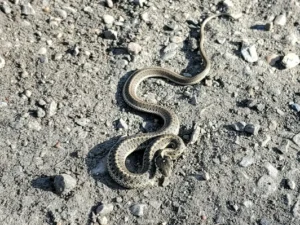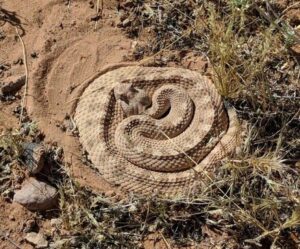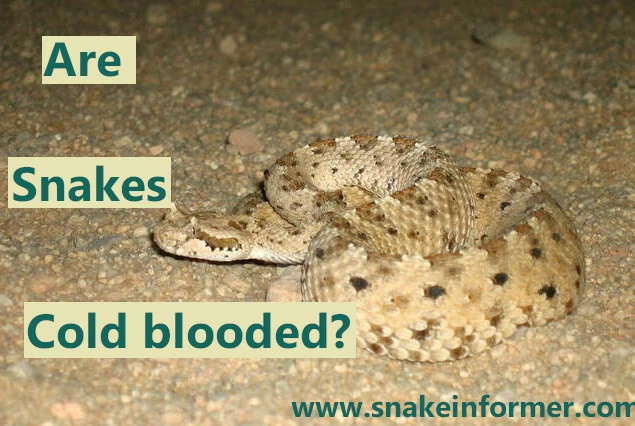In the winter, we don’t see any snakes moving around, or exploring their environment. This is because snakes, like all reptiles, rely on their environment to regulate their body temperature.
Snakes are ectothermic (cold-blooded) animals, which means they cannot regulate their body temperature. Their body temperature changes as the temperature in their surroundings changes.
When it’s warm, their bodies soak up the heat, and their body temperature rises. When it’s cooler, their body temperature falls.
That being said, it’s important to note that “ cold-blooded” is a slightly inaccurate term. The correct term is “ectothermic”.
Snakes Do Not Have “Cold Blood”
Many people have the misconception that ectothermic animals have “cold blood”. However, this is not true.
Being ectothermic or “cold-blooded” simply means that snakes cannot generate their own body heat, so their body temperatures are close to the temperature of their environment.

In other words, their environment is the main influence on their body temperature.
For example, a snake in an environment with an atmospheric temperature of 30°C (86°F), has a body temperature very close to 30°C.
In a 15°C (59°F) environment, the body temperature of the same snake is around 15°C.
This is in contrast to endothermic (warm-blooded) animals, like humans whose bodies can generate their own internal heat through their metabolism.
The Differences Between Endothermic (Warm-Blooded) And Ectothermic (Cold-Blooded) Animals:
Endothermic (Warm-Blooded) |
Ectothermic (Cold-Blooded) |
| Their core body temperature usually remains constant. | They do not have a specific core body temperature and it changes it according to the surrounding temperature. |
| Environmental changes have little to no effect on their metabolic rates. | Their metabolic rates change based on environmental temperature. |
| They can easily produce heat using the energy within their body. | They mainly depend on direct sunlight and heat from the surrounding environment. |
How Do Snakes Regulate Their Body Temperature?
Since snakes can not generate their own internal heat, they rely on external heat sources such as the sun to keep their bodies at optimal temperatures.
As the temperature changes at different times of day and night, they move around their environment to regulate their body heat. This is known as “behavioral thermoregulation.”
When their body temperature is low, they move into the sun to warm up, when it is high, they move to the shade or cool water to cool down.

In addition, snakes often hide in underground burrows, in rock crevices, in tree stumps, or even under leaf litter – to shield themselves from heat.
Many snakes also often climb into trees to warm up and bask in the sunlight.
A few species, such as garter snakes, even gather in groups to retain body heat during cold weather.
Being “Cold-Blooded” Has Advantages
Being ectothermic gives snakes many advantages that endothermic (warm-blooded) animals do not have.
1. They Require Less Food
Warm-blooded animals use a lot of energy to generate their body heat and maintain a constant temperature.
Since snakes do not generate their own body heat, they do not need much energy to regulate their body temperature. This means they require less food to survive and have to eat less often.
Many snakes in the wild can survive with only one meal a week, especially if the environmental temperatures are low.
Also, when the weather is cold, and food is scarce, snakes become inactive and don’t need to eat or will eat very little.
2. They Can Live In Harsh Environments
Since snakes do not require lots of energy to regulate their body temperature, they can live in environments with little food, which would be off-limits to most warm-blooded predators.
3. They Are Not Good Hosts for Most Bacteria and Parasites
Snakes do not have a constant body temperature. Their body temperature changes with that of their environment.
This means they are not good hosts for many bacteria and parasites that thrive in maintained warm temperatures.
It is difficult for most bacteria and parasites to live in an environment where the temperature frequently changes.
Warm-blooded animals have a constantly warm body temperature, creating a good environment for bacteria and viruses to live.
To counter this, most warm-blooded animals have very good immune systems.
Being Cold-Blooded Also Has Its Disadvantages
Even with many benefits, being cold-blooded also puts snakes at some disadvantages.
1. Snakes Tend to Be Sluggish in Cold Weather
Because snakes depend on the environment to regulate their body temperature, they tend to be slow and sluggish when the weather is cooler.
When the weather warms up, they need to soak up the heat from the sun and before can get more active.
2. Snakes Cannot Survive in Extreme temperatures
Snakes need external heat sources, so climates with constantly low, or high temperatures are too hostile for them to live in.
For this reason, most snakes are restricted to warmer regions of the world, where they can soak up heat from the environment.
How Do Snakes Survive Extreme Temperatures?
Exposure to extreme temperatures can be harmful to any animal, whether cold or warm-blooded.
For cold-blooded animals, this risk of injury or death is even greater because their body temperature is dependent on the temperature of the environment they are in.
For this reason, snakes have adapted to cope with both cold and extreme heat.
To deal with cold winter temperatures, snakes migrate to overwintering sites that insulate and protect them from the cold.
They may overwinter in abandoned small mammal burrows, rock crevices, caves, hollow logs, or underneath leaf litter or debris.
In some regions, a few snake species are even known to hibernate underwater.
When the temperature drops, snakes enter a state of dormancy where their metabolism drops by up to 95 percent.
This allows them to survive without food all winter long, so they do not have to go out to forage for food in the bitter cold.
How Snakes Survive the Summer Heat
In the summer when the temperatures rise, snakes will keep cool by spending most of their under rocks, logs, and over natural cover, often near water bodies.

Sometimes, snakes even enter a state of dormancy when the environmental conditions are very hot and dry. This is known as estivation (also spelled as aestivation).
During estivation, the breathing rate, heart rate, and general metabolic rate all decrease, just as they do in hibernation. Think of it as some sort of “summer hibernation”.
If the summer weather gets too harsh, snakes will find a cool, safe place and estivate until the conditions are more favorable.
Estivation usually only lasts a few weeks. This is in contrast to hibernation/brumation which lasts several months.
Conclusion
Snakes are ectothermic animals. However, this does not mean they have “cold blood”.
It simply means that they can not generate their internal body heat, so they rely on external heat sources to regulate their body temperature.
As the temperature changes at different times of day and night, they move around in their environment to regulate their body heat.
When the winter comes, they migrate to overwintering sites to protect themselves from the cold.
Sources:
Andrade DV, Gavira RS, Tattersall GJ. Thermogenesis in ectothermic vertebrates. Temperature (Austin). 2015 Dec 30;2(4):454. doi: 10.1080/23328940.2015.1115570. PMID: 27227064; PMCID: PMC4843938.
Butler, Patrick & Brown, J. & Stephenson, D. & Speakman, John. (2023). Temperature regulation in ectotherms. 10.1093/hesc/9780199655458.003.0012.
Abe AS. Estivation in South American amphibians and reptiles. Braz J Med Biol Res. 1995 Nov-Dec;28(11-12):1241-7. PMID: 8728854.
Hi, my name is Ezra Mushala, i have been interested animals all my life. I am the main author and editor here at snakeinformer.com.

